When NASA sent humans to the Moon for the very first time, it wanted its astronauts prepared for anything. So in addition to food, maps, and medical supplies, Apollo 11 carried a giant, 43cm knife into space.
Yes, Neil Armstrong, Buzz Aldrin, and Michael Collins headed to the Moon with a machete on board. The knife, manufactured by W.R. Case & Sons Cutlery Company, was part of a standard Apollo mission survival kit.
This year, the company produced a $US233 ($331) commercial replica to commemorate the 50th anniversary of the Moon landing. I did my best to try it out — within the limits of New York City’s weapons laws.
It’s fun to imagine Aldrin wielding a machete in his spacesuit to defend himself from alien attacks, but the knife’s intended purpose was a bit more terrestrial than that.
“From the start of Project Mercury, NASA has always provided survival equipment in spacecraft just in case there is a need for an unscheduled landing somewhere on Earth,” explained NASA Chief Historian Bill Barry in an email to Gizmodo. “Since most of the Earth is covered by water, the survival kits have life rafts and floatation devices, but they also include land survival items that would allow crews to safely wait for pickup in most conditions.”
Basically, the astronauts were slated to land in the Pacific Ocean, with ships located at specific coordinates ready to pick up the module. But should the capsule have ended up somewhere else, far from its retrievers, the astronauts could use the contents of two emergency rucksacks to survive.
According to press materials distributed ahead of the Apollo 11 mission in 1969, the kit was designed to “provide a 48-hour post-landing (water or land) survival capability for three crewmen between 40 degrees North and South latitudes.” In addition to the machete, the rucksacks kept above the Moon lander’s pilot’s seat contained a three-person raft, sunglasses, a first aid kit, spare water, radio equipment, sunscreen, and a desalination kit.
While NASA didn’t explicitly state why it thought its astronauts needed a giant jungle knife (Barry simply referred to it as a “cutting tool”), it’s easy to guess what it was meant to do: exactly what any other machete does. A knife like this could clear a path through bushy undergrowth, strip tree bark, or peel fruit. Perhaps it could also be used to hunt or defend oneself.
So, let’s talk about the knife. The stainless steel blade on W.R. Case & Son’ s reproduction extends almost 30cm from the handle, with a sharpened edge on one side and a saw blade covering most of the spine. The scales are made of a white synthetic polymer, secured by brass pins.
Though the scales of the replica appear to be 3D-printed, the knife’s accompanying fact sheet states that the handle materials were specifically selected so the knife wouldn’t outgas and introduce particles into the atmosphere of the Apollo capsule. The knife also had to be lightweight and non-flammable. Ultimately, the machete Apollo 11 carried had aluminium scales instead of a plastic handle, as well as a metal sheath that would prevent it from hurting anyone if it jarred loose and started floating around the capsule.
“What a cool knife,” said Gizmodo editor and blade connoisseur Hudson Hongo before swinging the knife around behind me, creating a whooshing sound as it cut through the air.
Finding a place in New York City to use the knife for its obvious function, clearing dense undergrowth, proved nearly impossible. The city outlaws carrying any knife with a blade longer than four inches in a public place, and the machete’s blade is much longer than that.
The only exceptions (for civilians) are when carrying such a knife to a place where it would be used for “hunting, fishing, camping, hiking, picnicking or any employment, trade or occupation customarily requiring the use of such knife.” This includes displaying it as part of a theatrical or military performance, transporting it between the place you bought it, your home, and a place to sharpen or repair it and carrying it as “a duly enrolled member of the Boy or Girl Scouts of America or a similar organisation or society” when having it is needed to participate in the group’s activities.
In other words, I could not take it to a park to clear bamboo and reeds. And despite asking plenty of friends, I could not find a yard with enough overgrowth to really feel like I was reenacting Predator. In the end, Gizmodo editor-in-chief Kelly Bourdet offered access to her own slightly shaggy backyard, so I had to settle for weed-whacking duty.
The thrill of swinging the machete wasn’t lost when attacking the wimpy mugwort, fleabane, and clover. I crouched over and hacked away, imagining that I wasn’t in my boss’s yard, but a wayward astronaut lost in a dense, tropical jungle. The knife wasn’t quite sharp enough to make clean cuts through the smallest growth, but I suppose it did everything a machete should do.
Not that you’re really supposed to clear brush with this knife. More likely, buyers will put the Moon machete up on their walls and “ooh” and “ahh” at the fact that they spent more than two hundred dollars on a replica of a knife NASA sent into space. That’s still cool, in my opinion, but if you need a machete, you can find a good one that didn’t have to be optimised for space travel for less than $50.
Still, if you ever do find yourself on the Moon battling hostile aliens, it’s nice to know that there’s an appropriate weapon available.
